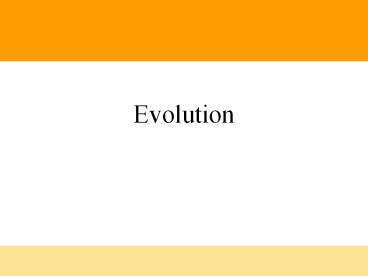Evolution - PowerPoint PPT Presentation
Title: Evolution
1
Evolution
2
Evolution
- Evolution a change in gene frequencies in
populations over time - Evolution explains
- origin of species,
- diversity of organisms and their relationships,
- similarities and differences among species,
- adaptation to the environment
3
CHARLES DARWIN ANDTHE ORIGIN OF SPECIES
- Charles Darwins On the Origin of Species by
Means of Natural Selection was published in 1859 - co-presented with Alfred Wallace
- Darwins 2 main points
- All organisms descended from ancestral species
- Natural selection was the mechanism for change
4
Darwins Theory of Natural Selection
- Darwin based his theory of natural selection on
two key observations - Overproduction
- All species tend to produce excessive numbers
- This leads to a struggle for existence
- Individual variation
- Variation exists among individuals in a
population - Much of this variation is heritable
5
Survival of the Fittest
- Inference Natural Selection leads to
differential reproductive success - Individuals best suited for the local environment
leave more fertile offspring - Evolution is the accumulation of more favorable
variants over time - Natural Selection operates at the level of the
individual, NOT for the good of the species
6
Natural Selection in Action
- Examples of natural selection include
- Pesticide resistance in insects
- The development of antibiotic-resistant bacteria
- Kettlewells Peppered Moths
7
Kettlewells Peppered Moths
- Kettlewell studied the peppered moth (Biston
betularia) from insect collections in England. - Birds ate moths that were easiest to find.
Selection for Light colored moths in
non-polluted areas
Selection for Black moths in polluted areas
8
Three General Outcomes of Natural Selection
- Directional Selection
- Selects in favor of one or the other extreme
- Diversifying Selection
- Selects in favor of two extreme types
- Stabilizing Selection
- Selects in favor of intermediate type
1) Directional Selection
3) Stabilizing Selection
2) Diversifying Selection
Selects in favor of two extreme types
Selects in favor of intermediate type
Selects in favor of one or the other extreme
9
Patterns of Evolution
- Convergent Evolution
- evolutionary change in two or more unrelated
organisms that results in the independent
development of similar adaptations to similar
environmental conditions - Example anteaters found in Australia, Africa,
North and South America
10
Patterns of Evolution
- Divergent Evolution
- occurs when a single group of organisms splits
into two or more groups and each group evolves in
increasingly different directions - Example Darwins Galapagos Finches
Figure 1.13
11
EVIDENCE FOR EVOLUTION
- Common ancestry and descent with modification are
found by studying - The fossil record
- organisms appear in a historical sequence
- Biogeography
- the geographic distribution of species
- Comparative anatomy
- comparison of structures in different species
- Comparative embryology
- comparison of structures that appear during
development - Molecular biology
- comparison of genes and proteins
(right) Comparative embryology of vertebrates
supports evolutionary theory
12
Homologous structures
- Homologous (also called divergent) structures
have a similar anatomy due to common ancestry - Same form (function may or may not be the same)
- Ex forelimbs of vertebrates
Human write
Cat Walk
Whale Swim
Bat Fly
13
Analogous structures
- analogous (also called "convergent") structures
have evolved independently - Serve the same function in different species
- Ex wings of butterfly and bird
Bird Fly
ButterflyFly
14
The Origin of Species
- The biological species concept defines species as
groups of interbreeding natural populations that
are reproductively isolated from other such
groups
(a) Similarity between different species
(b) Diversity within one species
Figure 14.4
15
Mechanisms of Speciation
- The two modes of speciation are
- Allopatric speciation
- other country
- Sympatric speciation
- same country
(b) Sympatric speciation
- Allopatric speciation
Figure 14.8
16
Allopatric Speciation
- Members of a population become physically
separated - The separated populations diverge, through
changes in mating tactics or use of their habitat - They become reproductively separated such that
they cannot interbreed and exchange genes
17
Sympatric Speciation
- a species splits into two due to reproductive
isolation without any geographic separation - Reproductive isolation may be
- Pre-zygotic
- Post-zygotic
18
Pre-zygotic barriers
- Pre-zygotic barriers impede mating between
species or hinder fertilization of eggs - Temporal isolation
- Habitat isolation
- Mechanical isolation
- Gametic isolation
- Behavioral isolation
19
Post-zygotic barriers
- Post-zygotic barriers are backup mechanisms that
operate should interspecies mating actually occur
and produce hybrid zygotes - Hybrid inviability
- Hybrid sterility
Horse
Mule (hybrid)
Donkey
Figure 14.7
20
Study Objectives
- Define evolution and describe Charles Darwins
contribution to the current Theory of Evolution. - Define natural selection and describe how natural
selection works to change a population. - Describe some examples of natural selection,
including Kettlewells study with the black and
peppered moths. - Contrast directional, diversifying, and
stabilizing selection. - Define convergent evolution and divergent
evolution and give an example of each. - Describe five main lines of evidence in support
of evolution. - Contrast homologous and analogous structures.
- Define species.
- Define speciation and describe two mechanisms by
which speciation can occur (allopatric,
sympatric). - Distinguish between pre-zygotic and post-zygotic
barriers and describe ways in which sympatric
populations can be reproductively isolated.































